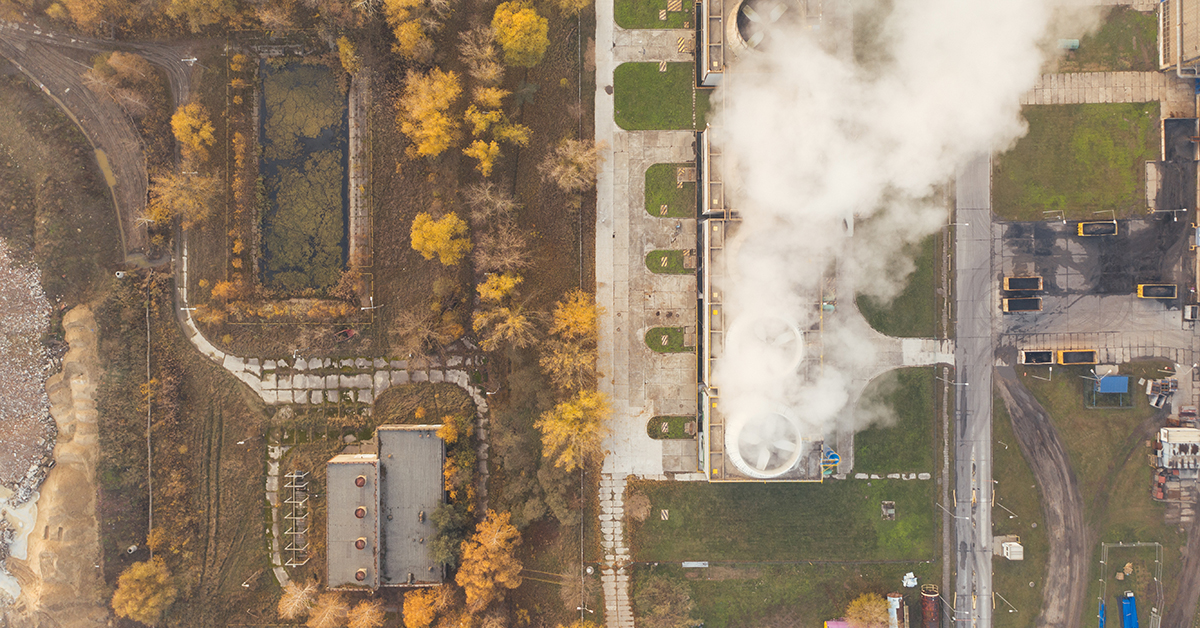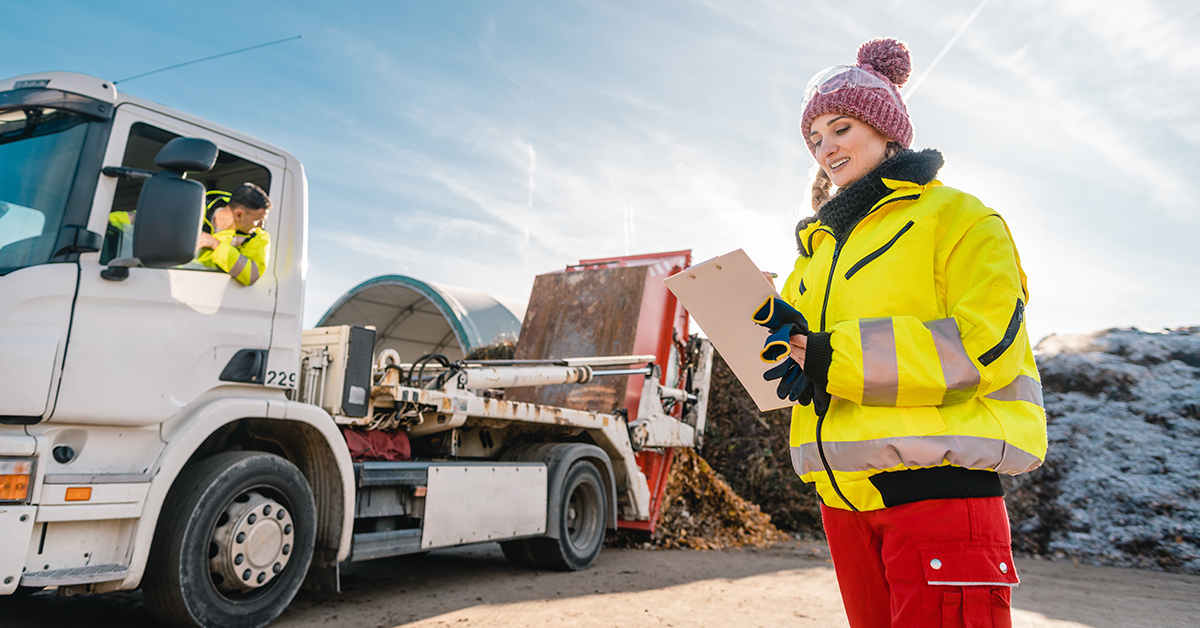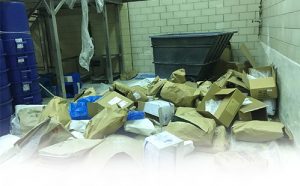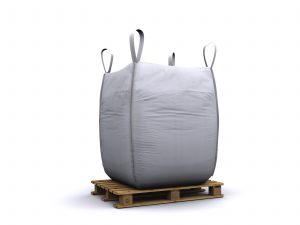by KenBay | Dec 11, 2023

The increasing global population and industrial activities have led to a surge in waste generation, posing significant challenges to environmental sustainability. Traditional waste disposal methods, characterized by landfills and incineration, have been a major contributor to environmental degradation. The following explores the environmental impact of these conventional methods and sheds light on how industrial trash compactors offer a sustainable solution to mitigate these issues.
(more…)
by KenBay | Nov 11, 2023

In the modern business landscape, efficiency, cost-effectiveness, and sustainability are paramount. An often overlooked yet critical component of achieving these goals is waste management. Industrial trash compactors can play a vital role in helping your business stay strong and competitive by addressing key aspects such as:
(more…)
by KenBay | May 4, 2023
 The excessive amounts of industrial non-hazardous waste is rapidly becoming an important issue for both developing and industrialized economic nations the world over. Countries are creating comprehensive waste management plans to help alleviate issues brought on by post-recycling, non-hazardous waste which would otherwise fester in landfills, causing ecological concerns. (more…)
The excessive amounts of industrial non-hazardous waste is rapidly becoming an important issue for both developing and industrialized economic nations the world over. Countries are creating comprehensive waste management plans to help alleviate issues brought on by post-recycling, non-hazardous waste which would otherwise fester in landfills, causing ecological concerns. (more…)
by KenBay | Nov 28, 2022

Countries all over the world are looking into comprehensive waste management plans to help alleviate issues brought on by excessive garbage. For almost 35 years, the Environmental Protection Agency (EPA) has tracked and reported on garbage statistics in the United States. The current rate of municipal solid waste (MSW) production is estimated by the government to be 292.4 million US short tons, or 4.9 pounds per person per day. Out of the MSW that was produced, about 69 million tons were recycled, and 25 million tons were composted.
(more…)
by KenBay | Aug 22, 2022

What Is the Internet of Things (IoT)?
The Internet of Things (IoT) describes the network of physical objects that are embedded with sensors, software, and other technologies for the purpose of connecting and exchanging data with other devices and systems.
(more…)
by CharlieB | Jun 28, 2017
 Water is wonderful. After all, we wouldn’t be able to live without it! But there are some places that we just don’t want to see water. Nobody’s happy to stumble upon a flooded basement, for example. Nor is it desirable to see enormous puddles in the yard. And of course, nobody wants to deal with excess water in their waste! Many manufacturers utilize dewatering equipment in order to keep their waste dry and easy to manage. But there are many other great reasons to do it that you may not know about! Here are 5 hidden benefits to employing more dewatering equipment in your waste management process.
Water is wonderful. After all, we wouldn’t be able to live without it! But there are some places that we just don’t want to see water. Nobody’s happy to stumble upon a flooded basement, for example. Nor is it desirable to see enormous puddles in the yard. And of course, nobody wants to deal with excess water in their waste! Many manufacturers utilize dewatering equipment in order to keep their waste dry and easy to manage. But there are many other great reasons to do it that you may not know about! Here are 5 hidden benefits to employing more dewatering equipment in your waste management process.
For questions about dewatering equipment or anything else to do with your waste compactor, turn to KenBay. We are an experienced company dedicated to proper waste management. Our goal is to lead companies to follow a zero landfill initiative through easy, efficient waste compactors. If you want to know more about KenBay and our zero landfill initiative, visit our website.
Why You Should Use Dewatering Equipment
Ability to Recycle More
At KenBay, we like to talk a lot about reducing the amount of “air” put onto the truck. Well guess what? Water works the same way. The more water is held inside of your waste, the less waste you’re able to fit onto the truck. Use dewatering equipment to save space, allowing you to recycle more when you need to. And you save money as well!
Less Trash to Landfill
One of the great things about dewatering is that it opens the door for opportunities to recycle. When waste is dewatered, it is transformed into a dry filter cake. Usually, that cake makes the waste easier to transport and dispose of. But when the cake is non-toxic, it can also be reused for other purposes. Thus, less trash gets sent off to the landfill overall.
Ability to Separate Plastic Cap From Cardboard Container
Plastic and cardboard can work well together, but they’re not the easiest to get rid of. They must be separated first, and recycled separately. Dewatering equipment can handle it easily!
Don’t Pay to Ship Remnant Ingredients
Little bits of leftovers can get annoying. They’re too small to do anything with, but it’s not worth paying to ship them or dispose of them. Dewatering equipment makes it so you won’t have to worry about that problem anymore!
Cleaner Plant Environment
A clean environment is a safe environment. And having wet, nasty waste everywhere definitely does not make for a clean environment. Turn to dewatering equipment to destroy the sludge, keep things dry, and make your workers happy!
KenBay Can Dewater . . . and So Much More
For dewatering applications the SC 2000 and SC 3000 Screw Compactors provide continuous throughput and are configured for de-packaging/de-watering or for foam densifying. These screw compactors can be an integral part of a system that will make your facility landfill free. The SC 2000/3000 is a low maintenance heavy-duty piece of equipment capable of handling large throughputs of material while still maintaining a high compaction rate continuously throughout the operation.
The output from them is ready for delivery to a Waste-To-Energy (WTE) facility having extracted whatever liquids they contain. The Screw Compactors perform well for de-packaging:
- milk
- yogurt
- soft drinks
- BBQ Sauces and ketchups
- ice cream
- liquid soaps and detergents
- and much more
To learn more go to “SC 2000 & 3000 Screw Compactors”
by timm | Jun 13, 2017
 Bakeries, ingredient processing companies, the granary and feed industry, among many other high and medium volume industries receive content in 50 lbs. bags. The bags are generally made of paper lined or reinforced with plastic. Problems these emptied bags create are the following
Bakeries, ingredient processing companies, the granary and feed industry, among many other high and medium volume industries receive content in 50 lbs. bags. The bags are generally made of paper lined or reinforced with plastic. Problems these emptied bags create are the following
- They are made of mixed materials, i.e., plastic and paper make them unfeasible to easily and properly recycle.
- Large volumes of bags require wasted hours of physical labor & forklifts to transport bags to waste compactor, especially to stationary compactors or dumpsters.
- Getting the bags transported and compacted to reduce hauling costs can be somewhat labor intensive.
The factors affecting the disposing of these 50 lbs. bags are that the bags need to be greatly compacted and it is highly desirable that it be done where the bags are emptied.
Compacting Bags Where They are Emptied
- The person handling the bags can throw the empty bags into the compactor located at the waste’s source without moving after emptying its content into a mixer or another machine. He/she will be the last person touching the bags in the disposal process. If a machine is used to open and empty the bags it can deposit the bags directly into the compactor. The compacting process is best accomplished with the use of a continuous compactor rather than a type of baler.
Dealing with the Dust
- Frequently the residue left in the bags creates a great deal of dust, especially in some instances near where food is being processed. A dust collector can be utilized to remove the dust from the environment from the chute in which the bags are thrown passing to an enclosed chamber compactor. Or dust collection can be done from the enclosed chamber. Compacting 50 lbss. bags into large plastic bags that can be sealed for transport also reduces ambient dust.
Reducing Labor & Hauling Costs:
- Costs are reduced with fewer trips either using a pallet jack or a forklift to remove the waste filled bag from the compactor to the hauler’s container outside. The waste filled bags contain approximately 800 50 lbs. bags. Contrast this to frequent trips hauling between 100 and 200 bags loosely placed on a pallet being hauled by forklift. Reducing forklift traffic on a factory floor is always a good thing in a number of ways, such as, safety, maintenance and cost reduction.
- One meter cubes of plastic filled waste are easily manageable for transporting either in a dumpster to landfill or in a covered trailer with double stacked bags to a Waste to Energy facility. Reducing the cost of transport of waste is critical to profitability in all types of waste disposal whether it be to landfill, recycling or Waste to Energy (WtE) facilities.
KenBay has been helping many companies in a variety of industries reduce labor and hauling costs of those ubiquitous 50 lbs. bags using the original industrial rotary arm compactor, the RotoPac. Why not go to the front page of www.kenbay.com and see the RotoPac in operation? If you would like to try out a KenBay RotoPac for yourself, you can try one before you buy one. Simply pay a small fee and we’ll send one to your location. After all, you have nothing to lose but costs.
by CharlieB | Jun 4, 2017
 What is waste management costing you? Many of you might think that it doesn’t take that much money. But waste management is a surprisingly large sinkhole which your cash will disappear into. The cost of the waste management is not the key element in this expensive equation. Rather, the small hidden costs which build up over time. These include maintenance, labor, and the materials themselves. The Ohio EPA breaks down the surprising costs of waste management. For some manufacturers, their expenses got so high they tripled the expected cost! So, what can you do? Well, there’s a few things experts (ourselves included) recommend you do to make sure you know what you’re actually paying. And there’s a few more things you can do to pay less!
What is waste management costing you? Many of you might think that it doesn’t take that much money. But waste management is a surprisingly large sinkhole which your cash will disappear into. The cost of the waste management is not the key element in this expensive equation. Rather, the small hidden costs which build up over time. These include maintenance, labor, and the materials themselves. The Ohio EPA breaks down the surprising costs of waste management. For some manufacturers, their expenses got so high they tripled the expected cost! So, what can you do? Well, there’s a few things experts (ourselves included) recommend you do to make sure you know what you’re actually paying. And there’s a few more things you can do to pay less!
For more great tips on recycling and waste management, rely on KenBay. We manufacture portable waste compactors for manufacturers and plants. We’re also committed to a zero waste initiative, and encourage other companies and corporations to follow suit!
What is Waste Management’s Hidden Fees?
It’s important to remember that waste management does not exist in a vacuum. Purchase of raw material is absolutely a factor in overall cost. As is maintenance and upkeep of that material once you have implemented it. Replacement parts also add to your overall costs. And we can’t forget the labor! You will require someone to install the raw material, someone else to replace parts, and someone else to (eventually) haul it all away. Bring those all together and it’s no wonder that waste management costs as much as it does!
So What Can You Do About It?
The first and most important thing you can do is be aware of your processes. This advice is not just for waste management, it’s makes for an overall more efficient plant. Be aware where your material comes from, how much is needed, and where it ends up. You are likely to end up discovering some wasted money. For example, you could discover that your company is spending extra on one certain raw material that it must then discard. Once you know these blind spots, work to correct them and minimize the loss of money.
Secondly, don’t be afraid to turn to secondary resources. The Environmental Protection Agency has great advice on waste management (such as the article linked above). KenBay also regularly provides advice through this blog.
As far as the waste disposal process goes, every little bit counts. One great way to save money is to use the right kind of compactor. KenBay’s RotoPacs save you money through creating efficiency and eliminating unnecessary functions. RotoPacs are portable, so they cut out some need for additional disposal labor. Simply throw the waste away at the source! Additionally, RotoPacs compact your waste efficiently into cube shapes. You can stack the waste cubes easily onto the truck, and therefore need fewer trips overall. If you want to try out a KenBay RotoPac for yourself, you can try one before you buy it. If you like the RotoPac, simply pay the difference to keep it there. Stay on top of your waste and your processes, and you may never need to ask yourself: “What is waste management really costing me?”
by CharlieB | May 16, 2017
 Got an old painting project that you haven’t done in a while? Maybe some old cans stored up in the garage that you haven’t used yet? What about if you’re involved in the manufacturing industry? Paint is certainly useful, but unused wasteful paint can actually be really harmful. Worse still, disposing of paint can get . . . complicated. So if you have some extra cans lying around, here’s some advice on how to get rid of old paint.
Got an old painting project that you haven’t done in a while? Maybe some old cans stored up in the garage that you haven’t used yet? What about if you’re involved in the manufacturing industry? Paint is certainly useful, but unused wasteful paint can actually be really harmful. Worse still, disposing of paint can get . . . complicated. So if you have some extra cans lying around, here’s some advice on how to get rid of old paint.
For this and other great waste removal tips, rely on KenBay to have the info you need. We commit ourselves to a zero-waste initiative, and encourage other companies to follow suit. visit KenBay’s website today and learn about our wide assortment of compactors available.
How to Get Rid of Old Paint (And Other Safety Tips)
-
Check what kind of paint it is
There’s basically two kinds of paint we’re concerned about: oil and latex. Latex is water based and very safe to store. Most of the paint you encounter for home use is latex based. Oil paint is highly toxic and flammable and should be handled with care. For these tips, we’ll be separating them into oil and latex categories.
-
Oil: Do NOT throw away in the trash
This is important with latex paint as well, but even more so for oil-based: do not just throw it away in the garbage! Oil paint could ignite easily and deal some serious fire damage to whoever is handling it.
-
Oil: Do not store for too long!
Equally as important: while you can store latex paint for a long time, oil paint will eventually reach an expiration limit. Once that occurs, it can emit dangerous toxic fumes.
-
Oil: Take to a proper facility which handles HHW.
Oil paint is classified as a HHW, which stands for Household Hazardous Waste. There are facilities specially handled to dispose of these kinds of materials. Find one in your local area to take your oil-based paint to.
-
Check your drop off-time
While you’re searching for an HHW disposal facility, make sure you check if there are any special regulated drop off or pickup times.
-
Latex: When Possible, Recycle Your Old Paint
Latex paint can be stored for a long time, but don’t let it go to waste on your shelf! It is possible to recycle old paint at special facilities. Find one in your local area! Or repurpose leftover paint for some other project. Perhaps there are some small toys in need a color touch up?
-
Latex: Donate to someone else in need.
If you can’t (or don’t want to) recycle your paint, see if someone else can use it!
-
Latex: If possible, move into a smaller jar or can.
If space is your main concern, it is perfectly fine to move your excess paint into a smaller mason jar or old soup can. Make sure you cover the lid completely with something like saran wrap so that it doesn’t dry.
-
Latex: Turn into a Dry Solid First
If you simply must dispose of your latex paint, don’t make a mess by pouring it into the trash. Instead, harden the paint first. Let it sit outside with the lid open and the sun will take care of the rest. After the paint is hardened, it is perfectly safe to throw out, along with the old can.
-
Latex: Mix with Newspaper or Cat Litter to Speed Dry
For the impatient among us, simply mix the old paint with shredded newspaper, sawdust, or cat litter. The material causes the paint to dry faster, and you will be able to dispose of it quicker.
We hope you found these tips on how to get rid of old paint useful! For non-paint related waste, trust KenBay to have the compactors you need. Our RotoPac can handle any major waste challenge with ease. If you want to experience one for yourself, you can try it before you buy it.
by CharlieB | Apr 22, 2017
 A Great New Deal!
A Great New Deal!
Are you tired of having to deal with bulk? You know, like those massive bulk bags that sit around taking up space? Bulk bags are great for importing and holding massive loads of stuff. But then they just sit there, taking up space, and being an eyesore. They’re way too big to throw out in the regular trash. And besides, all of that hard plastic is terrible for the environment! What can you do?
Well, worry not because KenBay has got you covered with new ‘Bulk B Gone’! That’s right, KenBay, the locally owned champions of the zero-waste initiative, brings you the next step in bulky waste management. For a few low cost payment installments, you to can own the fantastic spray that makes bulk bags disappear like magic! Our specialized chemical blend breaks down the polymers of the plastic into an environmentally friendly —
Oh.
You’re not really buying any of this, are you?
Ok, the truth is there is no spray that can make hard plastic bulk bags, also known as “super sacks,” disappear “like magic.” But that doesn’t mean that you can’t make them go away. Bulk bags are a big problem for waste management. They are difficult to deal with for a variety of reasons. One of the biggest issues is the general lack of awareness about them. Can you name what most bulk bags are made of? Do you know how to properly recycle or reuse them? The answer to both is probably no. Most of us use the benefits of the bulk bags without considering the environmental impact. So what can we do?
Battle of the Bulk
One of the best things that we can do is to break those bulk bags down . . . hard. This, as you can imagine, is not an easy task! Hard plastic polymers make up the bulk bags. That means they’re not going to break down with your regular methods. What you need is some heavy duty equipment designed to break down that plastic. Equipment which compress waste so it’s easy to toss or recycle. Fortunately, KenBay has such equipment available! Our RotoPacs are heavy-duty, and powerful to boot! As you can see in these videos, the rotating arm of the RotoPac is continuously moving. So what does this mean for the waste inside? For starters, the RotoPac cruses the waste into a convenient cube shape.
The RotoPac is powerful enough to handle any bulk bag tossed inside it. And the RotoPac is portable, so you can use it right at the source of the waste. Also, it’s mostly self-automated, and only requires one worker to remove the waste. And that frees up the rest of your staff to go on with their regular jobs! So check out KenBay’s wide selection of waste compactors today. If you like what you see, you can try one before you buy it. We’ll ship you the trial RotoPac wherever you want, and you’ll experience the power for yourself. Best of all, KenBay makes it easy to keep the RotoPac: simply pay the difference and keep the one we send you! Rely on KenBay for bulk bags or any of your waste needs.




 The excessive amounts of industrial non-hazardous waste is rapidly becoming an important issue for both developing and industrialized economic nations the world over. Countries are creating comprehensive waste management plans to help alleviate issues brought on by post-recycling, non-hazardous waste which would otherwise fester in landfills, causing ecological concerns.
The excessive amounts of industrial non-hazardous waste is rapidly becoming an important issue for both developing and industrialized economic nations the world over. Countries are creating comprehensive waste management plans to help alleviate issues brought on by post-recycling, non-hazardous waste which would otherwise fester in landfills, causing ecological concerns. 

 Water is wonderful. After all, we wouldn’t be able to live without it! But there are some places that we just don’t want to see water. Nobody’s happy to stumble upon a flooded basement, for example. Nor is it desirable to see enormous puddles in the yard. And of course, nobody wants to deal with excess water in their waste! Many manufacturers
Water is wonderful. After all, we wouldn’t be able to live without it! But there are some places that we just don’t want to see water. Nobody’s happy to stumble upon a flooded basement, for example. Nor is it desirable to see enormous puddles in the yard. And of course, nobody wants to deal with excess water in their waste! Many manufacturers  Bakeries, ingredient processing companies, the granary and feed industry, among many other high and medium volume industries receive content in 50 lbs. bags. The bags are generally made of paper lined or reinforced with
Bakeries, ingredient processing companies, the granary and feed industry, among many other high and medium volume industries receive content in 50 lbs. bags. The bags are generally made of paper lined or reinforced with  What is waste management costing you? Many of you might think that it doesn’t take that much money. But waste management is a surprisingly large sinkhole which your cash will disappear into. The cost of the waste management is not the key element in this expensive equation. Rather, the small hidden costs which build up over time. These include maintenance, labor, and the materials themselves. The Ohio EPA
What is waste management costing you? Many of you might think that it doesn’t take that much money. But waste management is a surprisingly large sinkhole which your cash will disappear into. The cost of the waste management is not the key element in this expensive equation. Rather, the small hidden costs which build up over time. These include maintenance, labor, and the materials themselves. The Ohio EPA Got an old painting project that you haven’t done in a while? Maybe some old cans stored up in the garage that you haven’t used yet? What about if you’re involved in the manufacturing industry? Paint is certainly useful, but unused wasteful paint can actually be really harmful. Worse still, disposing of paint can get . . . complicated. So if you have some extra cans lying around, here’s some advice on how to get rid of old paint.
Got an old painting project that you haven’t done in a while? Maybe some old cans stored up in the garage that you haven’t used yet? What about if you’re involved in the manufacturing industry? Paint is certainly useful, but unused wasteful paint can actually be really harmful. Worse still, disposing of paint can get . . . complicated. So if you have some extra cans lying around, here’s some advice on how to get rid of old paint. A Great New Deal!
A Great New Deal!